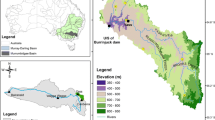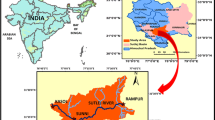Abstract
Hydrologiska Byrans Vattenbalansavdeling (HBV) Light model was used to evaluate the performance of the model in response to climate change in the snowy and glaciated catchment area of Hunza River Basin. The study aimed to understand the temporal variation of streamflow of Hunza River and its contribution to Indus River System (IRS). HBV model performed fairly well both during calibration (R2=0.87, Reff=0.85, PBIAS=−0.36) and validation (R2=0.86, Reff=0.83, PBIAS=−13.58) periods on daily time scale in the Hunza River Basin. Model performed better on monthly time scale with slightly underestimated low flows period during both calibration (R2=0.94, Reff=0.88, PBIAS=0.47) and validation (R2=0.92, Reff=0.85, PBIAS=15.83) periods. Simulated streamflow analysis from 1995–2010 unveiled that the average percentage contribution of snow, rain and glacier melt to the streamflow of Hunza River is about 16.5%, 19.4% and 64% respectively. In addition, the HBV-Light model performance was also evaluated for prediction of future streamflow in the Hunza River using future projected data of three General Circulation Model (GCMs) i.e. BCC-CSM1.1, CanESM2, and MIROCESM under RCP2.6, 4.5 and 8.5 and predictions were made over three time periods, 2010–2039, 2040–2069 and 2070–2099, using 1980–2010 as the control period. Overall projected climate results reveal that temperature and precipitation are the most sensitive parameters to the streamflow of Hunza River. MIROC-ESM predicted the highest increase in the future streamflow of the Hunza River due to increase in temperature and precipitation under RCP4.5 and 8.5 scenarios from 2010–2099 while predicted slight increase in the streamflow under RCP2.6 during the start and end of the 21th century. However, BCCCSM1.1 predicted decrease in the streamflow under RCP8.5 due to decrease in temperature and precipitation from 2010–2099. However, CanESM2 predicted 22%-88% increase in the streamflow under RCP4.5 from 2010–2099. The results of this study could be useful for decision making and effective future strategic plans for water management and their sustainability in the region.
Similar content being viewed by others
References
Adnan M, Nabi G, Kang S, et al. (2017) Snowmelt runoff modelling under projected climate change patterns in the Gilgit River Basin of Northern Pakistan. Polish Journal of Environmental Studies 26: 525–542. https://doi.org/10.15244/pjoes/66719
Akhtar M, Ahmad N, Booij MJ (2008) The impact of climate change on the water resources of Hindukush–Karakorum–Himalaya region under different glacier coverage scenarios. Journal of hydrology 355: 148–163. https://doi.org/10.1016/j.jhydrol.2008.03.015
Ali AF, Xiao C, Anjum MN, et al. (2017) Evaluation and Comparison of TRMM Multi–Satellite Precipitation Products With Reference to Rain Gauge Observations in Hunza River Basin, Karakoram Range, Northern Pakistan. Sustainability 9(11). https://doi.org/10.3390/su9111954
Archer D (2003) Contrasting hydrological regimes in the upper Indus Basin. Journal of Hydrology 274: 198–210. https://doi.org/10.1016/S0022-1694(02)00414-6
Arnell NW (2004) Climate change and global water resources: SRES emissions and socio–economic scenarios. Global Environmental Change 14: 31–52. https://doi.org/10.1016/j.gloenvcha.2003.10.006
Berg P, Feldmann H, Panitz HJ (2012) Bias correction of high resolution regional climate model data. Journal of Hydrology 448: 80–92. https://doi.org/10.1016/j.jhydrol.2012.04.026
Bergström S (1992) The HBV–Model–Its Structure and Applications. SMHI Reports RH No. 4, Norrköping.
Bergstrom S (1976) Development and application of a conceptual runoff model for Scandinavian catchments. SMHI Norrköping, Report RH07.
Bocchiola D, Diolaiuti G (2013) Recent (1980–2009) evidence of climate change in the upper Karakoram, Pakistan. Theoretical and Applied Climatology 113: 611–641. https://doi.org/10.1007/s00704-012-0803-y
Bolch T, Kulkarni AV, Kaab A, et al. (2012) The state and fate of Himalayan glaciers. Science 336: 310–314. https://doi.org/10.1126/science.1215828
Braun L, Renner CB (1992) Application of a conceptual runoff model in different physiographic regions of Switzerland. Hydrological Sciences Journal 37: 217–231. https://doi.org/10.1080/02626669209492583
Burhan A, Waheed I, Syed AAB, et al. (2015) Generation of high–resolution gridded climate fields for the Upper Indus River Basin by Downscaling Cmip5 Outputs. Journal of Earth Science and Climatic Change 6(2). https://doi.org/10.4172/2157-7617.1000254
Chiew FHS, Kirono DGC, Kent DM, et al. (2010) Comparison of runoff modelled using rainfall from different downscaling methods for historical and future climates. Journal of Hydrology 387: 10–23. https://doi.org/10.1016/j.jhydrol.2010.03.025
Gardelle J, Berthier E, Arnaud Y (2012) Slight mass gain of Karakoram glaciers in the early twenty–first century. Nature geoscience 5: 322–325. https://doi.org/10.1038/ngeo1450
Garee K, Chen X, Bao A, et al. (2017) Hydrological Modeling of the Upper Indus Basin: A Case Study from a High–Altitude Glacierized Catchment Hunza. Water 9(1). https://doi.org/10.3390/w9010017
Gul C, Kang S, Ghauri B, et al. (2017) Using Landsat images to monitor changes in the snow–covered area of selected glaciers in northern Pakistan. Journal of Mountain Science 14: 1–15. https://doi.org/10.1007/s11629-016-4097-x
Hewitt K (2005) The Karakoram anomaly? Glacier expansion and the ‘elevation effect’, Karakoram Himalaya. Mountain Research and Development 25: 332–340. https://doi.org/10.1659/0276-4741(2005)025[0332:TKAGEA]2.0.CO;2
Hewitt K (2011) Glacier change, concentration, and elevation effects in the Karakoram Himalaya. Upper Indus Basin. Mountain Research and Development 31: 188–200. https://doi.org/10.1659/MRD-JOURNAL-D-11-00020.1
Hock R (2003) Temperature index melt modelling in mountain areas. Journal of hydrology 282: 104–115. https://doi.org/10.1016/S0022-1694(03)00257-9
Immerzeel WW, Pellicciotti F, Bierkens MFP (2013) Rising river flows throughout the twenty–first century in two Himalayan glacierized watersheds. Nature Geoscience 6: 742–745. https://doi.org/10.1038/NGEO1896
Immerzeel WW, Van Beek LPH, Bierkens MFP (2010) Climate change will affect the Asian water towers. Science 328: 1382–1385. https://doi.org/10.1126/science.1183188
IPCC (2007) Summary for policymakers. In: Solomon S, Qin D, Manning M, et al. (eds.), Climate Change 2007: The Physical Science Basis. Contribution of Working Group I to the Fourth Assessment Report of the Intergovernmental Panel on Climate Change. Cambridge University Press, Cambridge, United Kingdom and New York, NY, USA.
IPCC (2013) Summary for Policymakers. In: Stocker TF, Qin D, Plattner GK, et al. (eds.), Climate Change 2013: The Physical Science Basis. Contribution of Working Group I to the Fifth Assessment Report of the Intergovernmental Panel on Climate Change. Cambridge University Press, Cambridge, United Kingdom and New York, NY, USA.
Iqbal M, Wen J, Wang X, et al. (2018) Assessment of air temeperature trends in the Source Region of Yellow River and its sub–basins, China. Asia–Pacific journal of Atmospheric Sciences 54(1): 111–123. https://doi.org/10.1007/s13143-017-0064-x
Kay AL, Davies HN, Bell VA, et al. (2009) Comparison of uncertainty sources for climate change impacts: flood frequency in England. Climatic Change 92: 41–63. https://doi.org/10.1007/s10584-008-9471-4
Konz M (2003) HBV3–ETH9 User’s Manual. Internal Report Bavarian Academy of Sciences, Commission of Glaciology, Munich.
Konz M, Seibert J (2010) On the value of glacier mass balances for hydrological model calibration. Journal of Hydrology 385: 238–246. https://doi.org/10.1016/j.jhydrol.2010.02.025
Kothawale DR, Revadekar JV, Kumar KR (2010) Recent trends in pre–monsoon daily temperature extremes over India. Journal of earth system science 119: 51–65. https://doi.org/10.1007/s12040-010-0008-7
Langsholt E, Lawrence D, Wong WK, et al. (2013) Effects of climate change in the Kolubara and Toplica Catchments, Serbia. Norwegian Water Resources and Energy Directorate, Oslo, Norway.
Li H, Beldring S, Xu CY, et al. (2015) Integrating a glacier retreat model into a hydrological model–Case studies of three glacierised catchments in Norway and Himalayan region. Journal of Hydrology 527: 656–667. https://doi.org/10.1016/j.jhydrol.2015.05.017
Lindström G, Johansson B, Persson M, et al. (1997) Development and test of the distributed HBV–96 hydrological model. Journal of Hydrology 201: 272–288. https://doi.org/10.1016/S0022-1694(97)00041-3
Mashingia F, Mtalo F, Bruen M (2014) Validation of remotely sensed rainfall over major climatic regions in Northeast Tanzania. Physics and Chemistry of the Earth, Parts A/B/C 67–69: 55–63. https://doi.org/10.1016/j.pce.2013.09.013
Matsuo K, Heki K (2010) Time–variable ice loss in Asian high mountains from satellite gravimetry. Earth and Planetary Science Letters 290: 30–36. https://doi.org/10.1016/j.epsl.2009.11.053
Moriasi DN, Arnold JG, Van Liew MW, et al. (2007) Model evaluation guidelines for systematic quantification of accuracy in watershed simulations. Transactions of the ASABE 50: 885–900. https://doi.org/10.13031/2013.23153
Nash JE, Sutcliffe JV (1970) River flow forecasting through conceptual models part I–A discussion of principles. Journal of hydrology 10: 282–290. https://doi.org/10.1016/0022-1694(70)90255-6
Rasul G, Mahmood A, Sadiq A, et al. (2012) Vulnerability of the Indus delta to climate change in Pakistan. Pakistan Journal of Meteorology 8(16).
Sagar S (2017) Hydrological modeling and climate change impact assessment using HBV Light Model: A case study of Karnali River Basin. XVI World Water Congress. International water resources association (IWRA), Cancun, Quintana Roo. Mexico.
Sarikaya MA, Bishop MP, Shroder JF, et al. (2012) Space–based observations of Eastern Hindu Kush glaciers between 1976 and 2007, Afghanistan and Pakistan. Remote sensing letters 3: 77–84. https://doi.org/10.1080/01431161.2010.536181
Schmidt S, Nüsser M (2012) Changes of high altitude glaciers from 1969 to 2010 in the Trans–Himalayan Kang Yatze Massif, Ladakh, northwest India. Arctic, Antarctic, and Alpine Research 44: 107–121. https://doi.org/10.1657/1938-4246-44.1.107
Seibert J (1997) Estimation of parameter uncertainty in the HBV model. Hydrology Research 28: 247–262. https://doi.org/10.2166/nh.1998.15
Seibert J (1999) Regionalisation of parameters for a conceptual rainfall–runoff model. Agricultural and Forest Meteorology 98–99: 279–293. https://doi.org/10.1016/S0168-1923(99)00105-7
Seibert J, Vis MJP (2012) Teaching hydrological modeling with a user–friendly catchment–runoff–model software package. Hydrology and Earth System Sciences 16: 3315–3325. https://doi.org/10.5194/hess-16-3315-201.
Sen PK (1968) Estimates of the Regression Coefficient Based on Kendall's Tau. Journal of the American Statistical Association 63: 1379–1389. https://doi.org/10.1080/01621459.1968.10480934
Shrestha M, Koike T, Hirabayashi Y, et al. (2015) Integrated simulation of snow and glacier melt in water and energy balance–based, distributed hydrological modeling framework at Hunza River Basin of Pakistan Karakoram region. Journal of Geophysical Research Atmospheres 120: 4889–4919. https://doi.org/10.1002/2014JD022666
Singh P (2001) Snow and glacier hydrology. Water science and technology library Vol. 37, Springer Publishers, Netherland.
Shen Y, Oki T, Utsumi N, et al. (2008) Projection of future world water resources under SRER scenarios: water withdrawal. Hydrological Sciences Journal 53: 11–33. https://doi.org/10.1623/hysj.53.1.11
Tahir AA, Chevallier P, Arnaud Y, et al. (2011) Snow cover dynamics and hydrological regime of the Hunza River basin, Karakoram Range, Northern Pakistan. Hydrology and Earth System Sciences 15: 2259–2274. https://doi.org/10.5194/hess-15-2275-2011
Teng J, Vaze J, Chiew FHS, et al. (2012) Estimating the Relative Uncertainties Sourced from GCMs and Hydrological Models in Modeling Climate Change Impact on Runoff. Journal of Hydrometeorology 13: 122–139. https://doi.org/10.1175/JHM-D-11-058.1
Terink W, Hurkmans RTWL, Torfs PJJF, et al. (2009) Bias correction of temperature and precipitation data for regional climate model application to the Rhine basin. Hydrology and Earth System Sciences Discussions 6: 5377–5413. https://doi.org/10.5194/hessd-6-5377-2009
Teutschbein C, Seibert J (2012) Bias correction of regional climate model simulations for hydrological climate–change impact studies: Review and evaluation of different methods. Journal of Hydrology 456: 12–29. https://doi.org/10.1016/j.jhydrol.2012.05.052
Thrasher B, Maurer EP, McKellar C, et al. (2012) Bias correcting climate model simulated daily temperature extremes with quantile mapping. Hydrology and Earth System Sciences 16: 3309–3314. https://doi.org/10.5194/hess-16-3309-2012
Uhlenbrook S, Seibert J, Leibundgut C, et al. (1999) Prediction uncertainty of conceptual rainfall–runoff models caused by problems in identifying model parameters and structure. Hydrological Sciences Journal 44: 779–797. https://doi.org/10.1080/02626669909492273
Wilby RL, Harris I (2006) A framework for assessing uncertainties in climate change impacts: Low–flow scenarios for the River Thames, UK. Water Resources Research 420: 563–575. https://doi.org/10.1029/2005wr004065
Xu CY (1999) Climate Change and Hydrologic Models: A Review of Existing Gaps and Recent Research Developments. Water Resources Management 13: 369–382. https://doi.org/10.1023/A:1008190900459
Xu M, Han H, Kang S (2017) Modeling Glacier Mass Balance and Runoff in the Koxkar River Basin on the South Slope of the Tianshan Mountains, China, from 1959 to 2009. Water 9(2). https://doi.org/10.3390/w9020100
Zhang Y, You Q, Chen C, et al. (2016) Impacts of climate change on streamflows under RCP scenarios: A case study in Xin River Basin, China. Atmospheric Research 178–179: 521–534. https://doi.org/10.1016/j.atmosres.2016.04.0
Acknowledgements
This study is supported by the National Natural Science foundation of China (Grant Nos. 41690145 and 41670158). We are thankful to the Surface Water Hydrology Project (SWHP) of Water and Power Development Authority (WAPDA) and Pakistan Meteorological Department (PMD) for providing the hydro-meteorological data to conduct this study.
Author information
Authors and Affiliations
Corresponding author
Rights and permissions
About this article
Cite this article
Ali, A.F., Xiao, Cd., Zhang, Xp. et al. Projection of future streamflow of the Hunza River Basin, Karakoram Range (Pakistan) using HBV hydrological model. J. Mt. Sci. 15, 2218–2235 (2018). https://doi.org/10.1007/s11629-018-4907-4
Received:
Revised:
Accepted:
Published:
Issue Date:
DOI: https://doi.org/10.1007/s11629-018-4907-4




